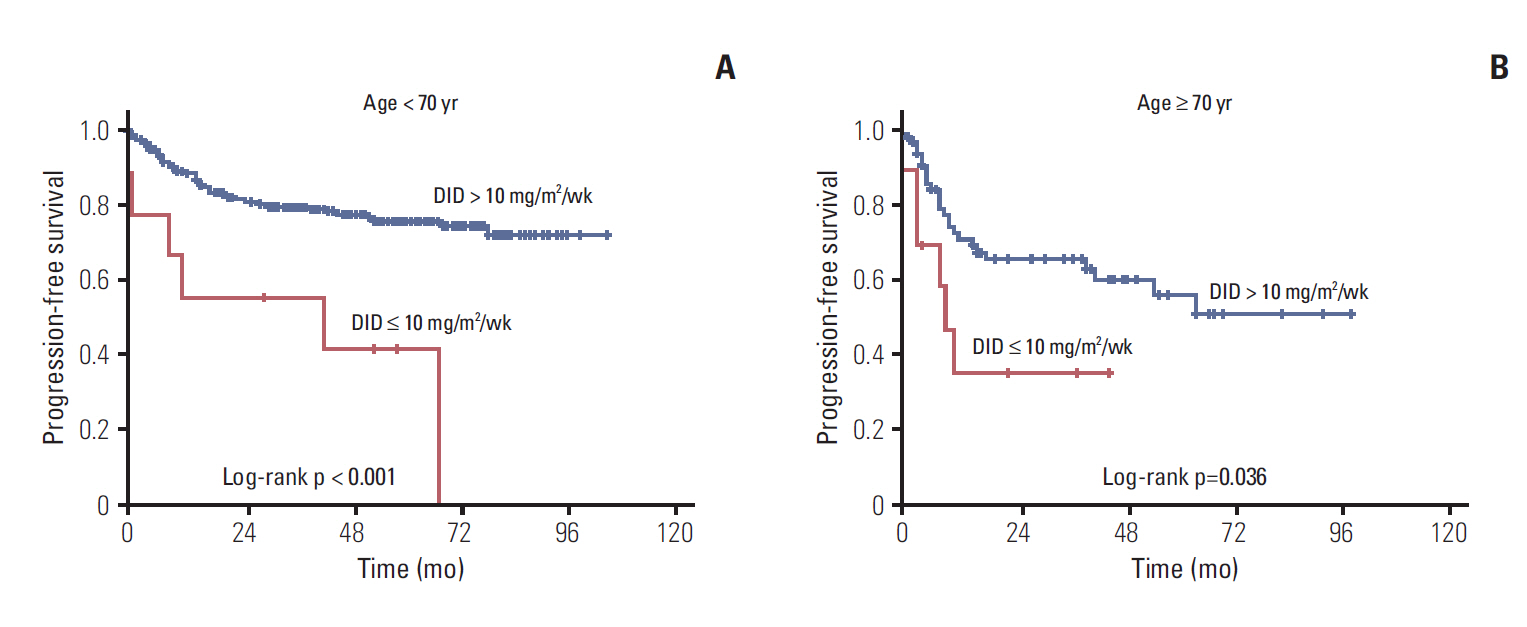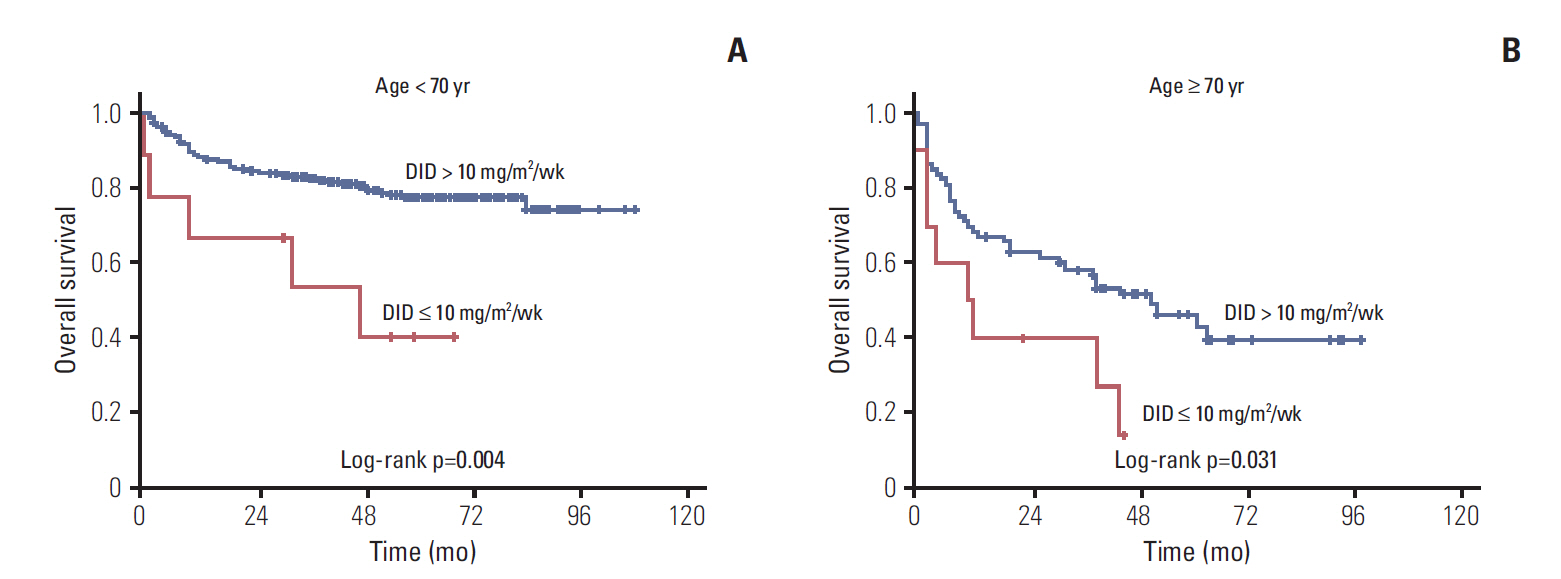Cancer Res Treat.
2016 Jan;48(1):304-311. 10.4143/crt.2014.339.
Reduced Dose Intensities of Doxorubicin in Elderly Patients with DLBCL in Rituximab Era
- Affiliations
-
- 1Department of Internal Medicine, Seoul National University Hospital, Seoul, Korea. bhumsuk@snu.ac.kr
- 2Cancer Research Institute, Seoul National University College of Medicine, Seoul, Korea.
- 3Department of Pathology, Seoul National University Hospital Seoul, Korea.
- KMID: 2152289
- DOI: http://doi.org/10.4143/crt.2014.339
Abstract
- PURPOSE
The dose intensity of doxorubicin (DID) is important to the survival of diffuse large B cell lymphoma (DLBCL) patients. However, due to expected toxicities, most elderly patients cannot receive full doses of anthracyclines. The purpose of this study was to evaluate the effect of DID on the survival of elderly DLBCL patients (age > or = 70 years) in the rituximab era.
MATERIALS AND METHODS
We analyzed 433 DLBCL patients who were treated with R-CHOP between December 2003 and October 2011 at the Seoul National University Hospital. Of these patients, 19.2% were aged > or = 70 years. We analyzed the survival outcomes according to DID.
RESULTS
Significantly poorer overall survival (OS) was observed for patients aged > or = 70 years (2-year OS rate: 59.9% vs. 84.2%; p < 0.001). DID < or = 10 mg/m2/wk had a significant effect on the OS and progression-free survival (PFS) in elderly patients (2-year OS rate: 40.0% in DID < or = 10 mg/m2/wk vs. 62.6% in DID > 10 mg/m2/wk; p=0.031; 2-year PFS: 35.0% vs. 65.7%; p=0.036). The OS on each 1.7 mg/m2/wk doxorubicin increment above 10 mg/m2/wk in elderly patients was not significant among the groups (2-year OS rate: 75.0% in DID 10.0-11.7 mg/m2/wk vs. 66.7% in DID 15.0-16.7 mg/m2/wk; p=0.859). Treatment related mortality was not related to DID.
CONCLUSION
DID can be reduced up to 10 mg/m2/wk in elderly DLBCL patients in the rituximab era. Maintenance of DID > 10 mg/m2/wk and judicious selection of elderly patients who are tolerant to DID is necessary.
MeSH Terms
Figure
Cited by 1 articles
-
Multicenter Retrospective Analysis of Clinical Characteristics, Treatment Patterns, and Outcomes in Very Elderly Patients with Diffuse Large B-Cell Lymphoma: The Korean Cancer Study Group LY16-01
Jung Hye Choi, Tae Min Kim, Hyo Jung Kim, Sung Ae Koh, Yeung-Chul Mun, Hye Jin Kang, Yun Hwa Jung, Hyeok Shim, So Young Chong, Der-Sheng Sun, Soonil Lee, Byeong Bae Park, Jung Hye Kwon, Seung-Hyun Nam, Jun Ho Yi, Young Jin Yuh, Jong-Youl Jin, Jae Joon Han, Seok-Hyun Kim
Cancer Res Treat. 2018;50(2):590-598. doi: 10.4143/crt.2017.172.
Reference
-
References
1. Morton LM, Wang SS, Devesa SS, Hartge P, Weisenburger DD, Linet MS. Lymphoma incidence patterns by WHO subtype in the United States, 1992-2001. Blood. 2006; 107:265–76.
Article2. Armitage JO. Treatment of non-Hodgkin's lymphoma. N Engl J Med. 1993; 328:1023–30.
Article3. Coiffier B, Thieblemont C, Van Den Neste E, Lepeu G, Plantier I, Castaigne S, et al. Long-term outcome of patients in the LNH-98.5 trial, the first randomized study comparing rituximab-CHOP to standard CHOP chemotherapy in DLBCL patients: a study by the Groupe d'Etudes des Lymphomes de l'Adulte. Blood. 2010; 116:2040–5.
Article4. Tirelli U, Errante D, Van Glabbeke M, Teodorovic I, Kluin-Nelemans JC, Thomas J, et al. CHOP is the standard regimen in patients > or = 70 years of age with intermediate-grade and high-grade non-Hodgkin's lymphoma: results of a randomized study of the European Organization for Research and Treatment of Cancer Lymphoma Cooperative Study Group. J Clin Oncol. 1998; 16:27–34.5. Armitage JO. Is lymphoma occurring in the elderly the same disease? Leuk Lymphoma. 2008; 49:14–6.
Article6. Huntington SF, Talbott MS, Greer JP, Morgan DS, Reddy N. Toxicities and outcomes among septuagenarians and octogenarians with diffuse large B-cell lymphoma treated with rituximab, cyclophosphamide, doxorubicin, vincristine and prednisone therapy. Leuk Lymphoma. 2012; 53:1461–8.
Article7. Lee KW, Kim DY, Yun T, Kim DW, Kim TY, Yoon SS, et al. Doxorubicin-based chemotherapy for diffuse large B-cell lymphoma in elderly patients: comparison of treatment outcomes between young and elderly patients and the significance of doxorubicin dosage. Cancer. 2003; 98:2651–6.8. Coiffier B, Lepage E, Briere J, Herbrecht R, Tilly H, Bouabdallah R, et al. CHOP chemotherapy plus rituximab compared with CHOP alone in elderly patients with diffuse large-B-cell lymphoma. N Engl J Med. 2002; 346:235–42.
Article9. Shin HJ, Chung JS, Song MK, Kim SK, Choe S, Cho GJ. Addition of rituximab to reduced-dose CHOP chemotherapy is feasible for elderly patients with diffuse large B-cell lymphoma. Cancer Chemother Pharmacol. 2012; 69:1165–72.
Article10. Feugier P, Van Hoof A, Sebban C, Solal-Celigny P, Bouabdallah R, Ferme C, et al. Long-term results of the R-CHOP study in the treatment of elderly patients with diffuse large B-cell lymphoma: a study by the Groupe d'Etude des Lymphomes de l'Adulte. J Clin Oncol. 2005; 23:4117–26.
Article11. Bastion Y, Blay JY, Divine M, Brice P, Bordessoule D, Sebban C, et al. Elderly patients with aggressive non-Hodgkin's lymphoma: disease presentation, response to treatment, and survival: a Groupe d'Etude des Lymphomes de l'Adulte study on 453 patients older than 69 years. J Clin Oncol. 1997; 15:2945–53.12. Campo E, Swerdlow SH, Harris NL, Pileri S, Stein H, Jaffe ES. The 2008 WHO classification of lymphoid neoplasms and beyond: evolving concepts and practical applications. Blood. 2011; 117:5019–32.
Article13. Cheson BD, Pfistner B, Juweid ME, Gascoyne RD, Specht L, Horning SJ, et al. Revised response criteria for malignant lymphoma. J Clin Oncol. 2007; 25:579–86.
Article14. Hryniuk WM, Goodyear M. The calculation of received dose intensity. J Clin Oncol. 1990; 8:1935–7.
Article15. Arcaini L, Rattotti S, Gotti M, Luminari S. Prognostic assessment in patients with indolent B-cell lymphomas. Scientific World Journal. 2012; 2012:107892.
Article16. Sehn LH, Berry B, Chhanabhai M, Fitzgerald C, Gill K, Hoskins P, et al. The revised International Prognostic Index (R-IPI) is a better predictor of outcome than the standard IPI for patients with diffuse large B-cell lymphoma treated with R-CHOP. Blood. 2007; 109:1857–61.
Article17. Peyrade F, Jardin F, Thieblemont C, Thyss A, Emile JF, Castaigne S, et al. Attenuated immunochemotherapy regimen (R-miniCHOP) in elderly patients older than 80 years with diffuse large B-cell lymphoma: a multicentre, single-arm, phase 2 trial. Lancet Oncol. 2011; 12:460–8.
Article18. Tsai HT, Pfeiffer RM, Warren J, Wilson W, Landgren O. The effects of cardiovascular disease on the clinical outcome of elderly patients with diffuse large B-cell lymphoma. Leuk Lymphoma. 2015; 56:682–7.
Article19. Sonneveld P, de Ridder M, van der Lelie H, Nieuwenhuis K, Schouten H, Mulder A, et al. Comparison of doxorubicin and mitoxantrone in the treatment of elderly patients with advanced diffuse non-Hodgkin's lymphoma using CHOP versus CNOP chemotherapy. J Clin Oncol. 1995; 13:2530–9.
Article20. Tilly H, Lepage E, Coiffier B, Blanc M, Herbrecht R, Bosly A, et al. A randomized comparison of ACVBP and CHOP in the treatment of advanced aggressive non-Hodgkin's lymphoma: the LNH93-5 study. Blood. 2000; 96:832A.21. Herbrecht R, Cernohous P, Engert A, Le Gouill S, Macdonald D, Machida C, et al. Comparison of pixantrone-based regimen (CPOP-R) with doxorubicin-based therapy (CHOP-R) for treatment of diffuse large B-cell lymphoma. Ann Oncol. 2013; 24:2618–23.
Article22. Kreher S, Lammer F, Augustin D, Pezzutto A, Baldus CD. R-split-CHOP chemotherapy for elderly patients with diffuse large B-cell lymphoma. Eur J Haematol. 2014; 93:70–6.
Article23. A predictive model for aggressive non-Hodgkin's lymphoma. The International Non-Hodgkin's Lymphoma Prognostic Factors Project. N Engl J Med. 1993; 329:987–94.24. Advani RH, Chen H, Habermann TM, Morrison VA, Weller EA, Fisher RI, et al. Comparison of conventional prognostic indices in patients older than 60 years with diffuse large B-cell lymphoma treated with R-CHOP in the US Intergroup Study (ECOG 4494, CALGB 9793): consideration of age greater than 70 years in an elderly prognostic index (E-IPI). Br J Haematol. 2010; 151:143–51.
- Full Text Links
- Actions
-
Cited
- CITED
-
- Close
- Share
- Similar articles
-
- Relevance of prognostic index with β2-microglobulin for patients with diffuse large B-cell lymphoma in the rituximab era
- Influence of NK cell count on the survival of patients with diffuse large B-cell lymphoma treated with R-CHOP
- Radioimmunotherapy with 131I-Rituximab in a Patient with Diffuse Large B-Cell Lymphoma Relapsed After Treatment with 90Y-Ibritumomab Tiuxetan
- Prognostic value of the absolute lymphocyte count reduction in patients with diffuse large B cell lymphoma treated with R-CHOP
- Primary diffuse large B-cell lymphoma of the bone marrow in a frail and elderly patient successfully treated with rituximab, cyclophosphamide, doxorubicin, vincristine, and prednisone





